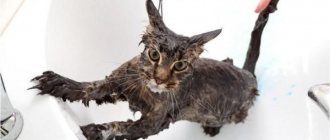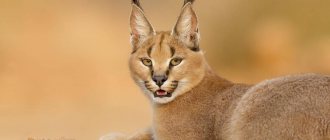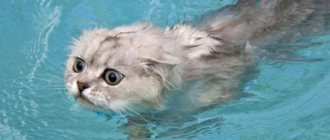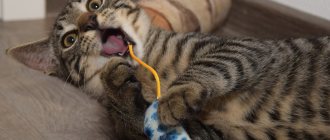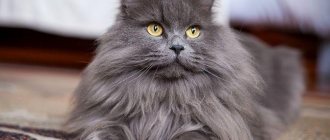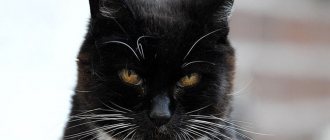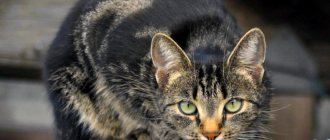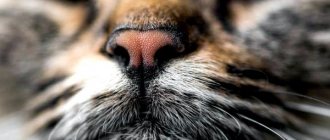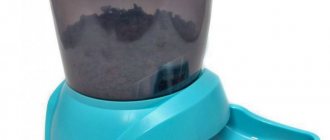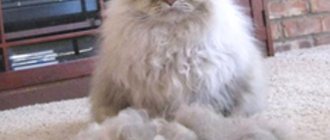Sincere love for pets often forces you to put up with scraps of fur that settle on clothes and furniture during molting. But there are cat breeds that do not shed and are very easy to keep at home.
Read the article to the end, there you will find useful information about animal shedding and allergies (not only to wool).
Sphinxes
Watch a video about cat breeds that do not shed on our Youtube channel Mr. Cat:
Werecat or Lykoi
If we really delve into the exotic, then those who like scarier things will definitely appreciate Likoi. This incredible breed in appearance really resembles a half-wolf, half-cat. The pet of this breed is not completely bald. Its coat simply has an uneven distribution, which gives it a somewhat frightening and folkloric appearance.
The fur of an adult may be completely absent or partially present on the body. The back is usually colored a smoky black, and the coat is ragged in texture. The body is quite flexible and at the same time strong. The head is wedge-shaped. This breed of hairless cats, if it can be classified as such, appeared due to a mutation. The latter manifested itself in the development of hair follicles.
Expert opinion
Danilova Maria Alekseevna
Therapist, dentist, ophthalmologist, surgeon, express tests, ratologist, groomer.
If compared with the same Dwelf and Elf, then the Likoi received official status as a separate type of cat. This happened in 2012.
Cornishrex
© shutterstock Cornish Rex cats are quite unique looking cats, as they have sparse fur and no guard hairs, which make up the top layer of fur that often protects cats from water. As you might have guessed, no guard hair means he loses less fur! These cats are very sociable and love human interaction. They are also slow to mature and will exhibit kitten-like behavior as adults.
Balinese
The Balinese breed comes from the Siamese, there are practically no differences between them except for the length of the coat. The Balinese are distinguished by a chic fluffy tail, which they carefully care for.
However, due to the lack of undercoat, these cats do not form tangles, and shedding is almost unnoticeable.
Nibelungs
The breed is young
...small in number, and, surprisingly, long-haired. Yes, all the previous non-shedding cats on our list were shorthaired, but there are always exceptions.
The coat of the Nibelung is a beautiful gray color, like that of its ancestor breed. In comparison with the Russian Blue breed, shedding is present, but this is a natural change in the long hair of the coat, which is more noticeable precisely because of the size of the hair. Timely brushing and a healthy diet make Nibelungs the record holders among long-haired cat breeds for modest shedding.
Care instructions
To prevent a cat from molting, it does not do so all year round, and seasonal molting takes place in a minimum period of time, a number of rules should be followed:
- Brush your pet with suitable brushes, mittens and slicker brushes. Any breed needs a regular schedule, be it Persian or Rex.
- Use only specialized pet shampoos. Even children's cosmetics can cause hair loss in a cat.
- Nutrition and a set of vitamins and minerals selected by a specialist for any breed can reduce daily shedding, and speed up and simplify seasonal shedding. A healthy cat always tolerates shedding easier and faster than a sick one.
- Stress can trigger shedding, and not always with subsequent hair regrowth. Take care of your cat.
Remember, the health and appearance of a cat always depends on the efforts of the owner.
Bambino
Bambino is often jokingly called the dachshund's love child. This is explained by the fact that this cat has a long body and short legs. Nevertheless, such a non-standard structure does not prevent them from being extremely curious and playful. The name of the breed translates as “child”. Considering the external childishness of the animal, which it retains into adulthood, the name of the breed fully justifies itself.
The skin is soft and covered with tiny folds. Short legs and hairless type were obtained through effective crossing of Don Sphynxes and Munchkins. The latter's paws are almost three times shorter than those of ordinary cats.
Features of shedding in cats
Molting is a natural process of changing fur in animals. Many wild animals need it for mimicry - for example, a dark color helps to hide against the background of the ground in the summer, a light color hides against the background of snow in the winter.
In addition, molting helps the animal adapt to the temperature regime: in the winter, some varieties of cats grow longer guard hairs, and the undercoat becomes denser and thicker. Such transitions are more pronounced in native breeds that formed in the wild, for example, in the Norwegian.
History of the Turkish Angora
The Turkish Angora is an indigenous breed of cat that has lived in the territory of modern Turkey since ancient times. It is named after the capital of the Ottoman state - Ankara.
Felinologists have proven that the angora is a descendant of a wild African cat domesticated by humans. There is a version that over time, these pets underwent two gene mutations: as a result of the first, their fur became longer; and as a result, the second one turned white.
The Turkish Angora cat breed was considered the most revered by the Ottomans. Only very rich people, for example, the Sultan and high dignitaries, could afford such an expensive pet.
Since the 16th century, Angora cats began to win the love of Europeans. Many Christian monarchs kept them. Catherine the Great accepted a snow-white long-haired purr as a gift from Count Potemkin.
Subsequently, Angoras mixed with Persian ones, which almost led to the degeneration of the breed. British and Turkish breeders began to restore the lost original characteristics. The result of colossal work was the official registration of the Angora cat breed in 1969.
Find the perfect cat for you
It is no secret that the appearance of hairless cat breeds is very exotic and does not correspond to the aesthetic preferences of all potential cat owners. Such cats are, as they say, an acquired taste. If you are a connoisseur of exotic things and are extremely intolerant of wool in your home, the Sphynx will suit you better than anyone else. If in your mind the cat is a wool cat, but a non-shedding member of the family, you should pay attention to representatives of low and moderate shedding breeds. There really is plenty to choose from here, including Rex and Siamese-Oriental cats, Bengal and Russian Blue - the appearance of such cats is the “golden mean” between long-haired beauties and their hairless relatives. Their short hair in most cases covers the entire body, and its amount during shedding is close to zero.
Having decided, however, to purchase a kitten of a hairless or short-haired breed, you need to find out other nuances of caring for a potential pet. Often, proper care for representatives of these breeds has its own difficulties, because it requires much more time and effort compared to periodically combing a pet’s fur and cleaning the apartment during seasonal molting.
Russian Blue
© shutterstock
Russian Blue cats are stunningly beautiful and are often dark gray or blue in color. They shed heavily, transitioning between summer and winter for about two weeks, but the rest of the year they shed minimally and are unlikely to cause serious allergic reactions. Regular brushing during these periods of heavy shedding will help reduce even seasonal shedding.
Shorthair
If you don’t like completely hairless cats, as well as their unusual appearance, then you should pay attention to the graceful representatives among short-haired cats.
Attention! Most individuals have short hair and a small undercoat, so caring for them is very easy.
Of course, if you are choosing which cats do not shed at all, then this breed will not be the best choice for you. We offer an overview of popular shorthair breeds:
- With regular short hair. These animals have undercoat and guard hair of different lengths. Popular among them are the American Curl, European Shorthair, and Kuril Bobtail. They will appeal to those who are choosing which breed of cat sheds the least among shorthairs.
- Plush (with double wool). These representatives have an undercoat equal in length to the awn. Among the popular individuals are the British, Russian blue breed, and exotics.
- Semi-longhaired. There is such a breed. They come in different varieties: without undercoat, like the Javanese, Balinese and Turkish Angora, and with undercoat, like Siberian cats, Karelian Bobtails and Maine Coons. These cats shed a lot, so caring for them is not the easiest.
The American Curl sheds the least among shorthairs.
In general, representatives of the breeds described above will have to be combed frequently. For example, a British cat has very short, soft and thick hair, and the undercoat is very well developed. Accordingly, you need to take care of them every day. The American Curl is distinguished by a small undercoat with a fairly long coat, so it also needs to be combed at least once every 2 weeks.
Separately, it is worth mentioning the Kuril Bobtail, whose coat does not require special care. He is one of the cat breeds that sheds little. The peculiarity of the bobtail coat is that it does not mat due to the hard and long outer hair, and the wool practically does not shed.
Rex
Which cats shed little but are beautiful in appearance? Many people like the Rex breed, which has curly hair.
Devon Rex does not cause any allergic reactions
There are many varieties of the breed, and each has its own characteristics, as well as its own color:
- Devon Rex: many people choose these animals because they do not cause any allergic reactions. Devon Rexes have very sparse and short hair, but it needs to be periodically combed, and the kitten itself needs to be bathed, as they get dirty too quickly and become sticky due to sebaceous secretions on the skin;
- Cornish Rex: representatives of this breed have very little hair, and they do not have guard hair, but only undercoat;
- Serkirk Rex: These cats can be short-haired or long-haired, but their coat is wavy and plush and resembles the coat of a sheep. Curls in the form of ringlets are especially found on the belly, neck, chest and panties of animals. So if you're looking for non-shedding cats other than Sphynx cats, go for the Rex. With a minimal amount of wool, they are very beautiful.
It is noteworthy that both sphinxes and rexes have an unusual appearance, and therefore they are valued by lovers of original breeds of pets.
List of breeds
Sphinx
The obvious answer to the question of which cats do not shed is Sphynx cats. First of all, these are St. Petersburg, Canadian and Don varieties of the breed. When crossed with them, they also obtained breeds that do not shed fur. These include Elf, Ukrainian Levkoy, Dwelf, Bambino. Representatives of this breed do not have thick fur. Only a few individual hairs, the length of which is no more than 2 mm. As a rule, even they fall out in adults (after 2 years).
There are many subspecies of sphinxes, however, they all belong to one group or another:
- Hungivores . Such individuals are born without fur and undercoat. They may not even have vibrissae (whiskers, eyebrows). In winter, such cats often acquire sparse fur of medium length.
- Flock, velor. Such individuals have a small, pleasant-to-the-touch undercoat. It's easy to guess from the name that it resembles velor fabric. Some individuals have fluff all over the body, while others have fur only on the muzzle and certain parts of the body. The absence of fur is an advantage for some owners, but at the same time it is associated with additional care requirements. These animals are cold, their skin easily becomes dry (especially during heating periods), in addition, brown sweat appears on the skin, which needs to be removed with soft napkins.
If this rule is not followed (as well as errors in nutrition), irritation and acne appear on the skin. Once a week, sphinxes are shown water treatments, which they do not have much love for.
In addition, Sphynx cats can leave greasy sweat stains on furniture. Sphinxes are characterized by a specific smell (albeit subtle). Some people do not notice it or are neutral towards its appearance, for others it is intolerable.
Rex
Rexes have a short and slightly wavy coat. Due to the fact that it fits tightly to the skin and has no undercoat, the cat does not shed. The breed has varieties, the most popular are:
- Devon - considered hypoallergenic, almost odorless, however, requires frequent bathing, since the fur becomes greasy from skin secretions;
- Cornish - has a sparse undercoat, rather reminiscent of fluff, they are also called alien cats for their large eyes and elongated muzzle;
- Laperm, Ural, German, Selkeers - there are both long-haired and short-haired individuals, they are united by the fact that the fur curls and resembles sheep's wool.
Rexes are neatly sized, small and graceful cats; their weight rarely exceeds 4-4.5 kg. The wool feels like fine suede to the touch.
Animals have a calm and kind disposition. Almost until old age they remain curious and playful. Unlike sphinxes, rexes are less demanding to care for - they do not need to be bathed or warmed so often. Cats have almost no smell and do not require brushing. But it is extremely important to monitor your pet’s diet - if it is disturbed, dark discharge appears on the back and sides.
Siamo-oriental group
This group brought together pets that do not have undercoat. The homeland of cats of the Siamese-Oriental group is warm countries. In other words, what makes them non-shedding is that their ancestors who lived in a warm climate did not need to change their fur. This genetic feature has been preserved in modern tailed animals of this group. As a rule, these cats have a graceful, elongated body, are muscular and agile. Outwardly, they resemble their ancestors - wild cats. This group includes:
- Siamese cats;
- Abyssinian cat;
- orientals;
- Thai cat;
- Mekong Bobtail;
- skif tai don;
- Burmese;
- Balinese
Representatives of all these breeds, with the exception of the Siamese, are distinguished by their inquisitive and friendly character and activity. Siamese cats cannot be called angry or aggressive, however, due to the anatomical features of the skeleton (“defects” of the spine and tail), the pet can often be irritable and vindictive. The guard hairs fall out unnoticed, and due to the lack of undercoat, the fur requires minimal care. It doesn't get into tangles.
The cats in question practically do not shed, however, if this happens, you should contact your veterinarian. This can signal a pet’s stress (often its consequences do not appear immediately, but after several months), hormonal imbalance or another pet disease.
Russian blue
This cat breed is one of the most sought after. And all thanks to his fantastic appearance and incredible character. The animal has a natural origin, an unusual color and is distinguished by its devotion to its owner, kindness, and paternal attitude towards younger family members. Despite the presence of a thick undercoat, the Russian Blue is not subject to shedding. In addition, the animal is clean and independently copes with the task of caring for its fur coat.
Cat fur is considered hypoallergenic. Due to the structure of the hair, it is not subject to destruction, and bacteria do not settle on it. Due to reduced hair fragility, the cat sheds throughout the year, but unnoticed. Longer hairs fall out, but the undercoat remains almost unchanged.
You can preserve the beauty of the fur by avoiding frequent washing and combing of your pet. Chemical compounds for grooming are also prohibited.
Nibelung
A rare cat breed for our country. In appearance it is similar to the Russian Blue, but is not shorthaired. The Nibelung has semi-long fur, but otherwise the hair structure is no different from the blue one. Knowing this, it is clear why the Nibelung is also a non-shedding cat.
Bengal
A cat of amazing beauty, intelligence and dexterity. And this is not surprising, because the ancestor of Bengals are Asian leopard cats. Bengals are the result of crossing a domestic and wild cat. A peculiarity of Bengals is that phasing begins a week after birth. This process involves increasing the length of the undercoat hair. The undercoat becomes longer than the guard hair, so the bright spotted color seems to be covered with a darker veil.
In nature, Asian cats practically merge with nature, and phasing is necessary to ensure that defenseless cubs are safe and do not become prey to predators. In domestic Bengals, the phasing process may not be so pronounced; their fur usually simply becomes unattractive (excessively fluffy, dense, the “signature” color is lost). The kitten grows, becomes more and more independent, strong, and fearless.
During this period (usually 4–9 months), the Bengal's undercoat falls out, it becomes smooth, shiny, and an exquisite pattern appears. The pet’s undercoat does not grow anymore, and from now on it can be considered a non-shedding cat.
Housey - from 3.2 to 6.8 kg
The Houseie is a relatively young cat breed. It appeared by crossing a domestic cat with a wild swamp lynx. Adult males have a body weight of 4 to 6.8 kg, while the weight of females varies between 3.2-4.5 kg. The body of this breed is long and slender, and the hind legs are longer than the front. The coat is short or medium length.
The Houseie is not a cat for first-time owners. The animal needs constant exercise and a lot of attention, and in this case the Housei will become an incredibly smart, good-natured and active pet. Houseies form deep bonds with people, so moving to another family would be extremely stressful for an adult animal.
Sphinxes
The light velor of the coat of all sphinxes is minimally susceptible to shedding, but for this reason the breeds have another unpleasant feature - sweat and skin secretions. Caring for Sphynxes and their mestizos does not involve combing, but rather regular wiping and bathing, because otherwise you will end up with a non-shedding, but very odorous cat.
IMPORTANT: Sphynx cats have a very calm character, but during the rutting or estrus period they become aggressive. Neutering is recommended if there is no goal of becoming a breeder. This way you will keep the cat's temperament in a standard calm state.
Or maybe vitamins?
As we have already said, almost all cats shed – some to a greater extent, some to a lesser extent. What vitamins should I give if my cat sheds a lot? In fact, no remedies are needed for them, unless there are allergic reactions, some hormonal changes, etc. Only a doctor can determine them.
If, nevertheless, no diseases are detected, you can give cats vitamins that will prevent hair loss. These can be either specially developed complexes or any vitamins that contain iodine, sulfur, seaweed extract and B vitamins. Complex vitamins are good because they have a balanced composition, including minerals.
Popular vitamin complexes that can take good care of your pet's fur include Kitty's + Taurin + Biotin, Cat–Fell OK, Laveta Super for Cats, Derm Caps and Derm Liquid. They contain biotin, zinc, taurine, and entire groups of vitamins, which together maintain the natural beauty of animal hair and prevent skin diseases.
Among the popular vitamin complexes are Kitty's + Taurin + Biotin
Remember that any vitamins can be given only after your pet has been examined by a veterinarian, as otherwise it can cause harm.
Pros and cons of non-shedding cats
A cat that doesn't shed has its advantages and disadvantages:
| pros | Minuses |
| No loose hair on carpets and furniture | Difficulty in skin care (hairless breeds) |
| Hypoallergenic | Special dietary requirements (for Sphynxes) |
| No need for frequent brushing |
The list of cats that don't shed or smell when properly cared for includes many dissimilar breeds. Therefore, it will certainly be useful not only for allergy sufferers, but also for those who dream of a four-legged pet, but are not ready to put up with balls of cat hair and the need to frequently clean.
Abyssinian
The Abyssinian fur coat is dense and very short, and does not require special care. The molting of an animal does not cause any trouble to the owner.
The maximum that can be found on a cat's bedding is a single tiny fiber. The Abyssinian cat is quite clean, quickly gets used to the litter box, and the presence of unpleasant odors is not typical for her.
Siberian
© shutterstock One look at these cats might make you think we included them on this list by mistake, as they have long, luxurious fur. However, by nature these cats shed very little and are even considered hypoallergenic, despite their long hair. If you're a fan of longer hair on your cat and don't mind it taking longer to groom, this may be the perfect cat breed for you.
Thai
The standard for this breed was registered relatively recently, in 1990. In appearance, Thai cats resemble rounded Siamese cats with shorter legs.
Thais are unpretentious and affectionate. Their shedding is rare and does not create problems because there is no undercoat. Animals do not have fatty or sweat glands, which eliminates their unpleasant odor.
Elf
This breed, like the previous one, will not be confused with the same sphinxes. This is explained by the special structure of the ears, the tips of which seem to be bent upward and backward. In appearance, the pet really has a somewhat good-natured, sweet and fairytale-like appearance, like a real elf. The texture of cat skin resembles soft cashmere.
Expert opinion
Slanimsky Alexey Georgievich
Veterinarian of the highest qualification category. Has extensive experience in diagnosing and treating diseases in animals.
Despite such an original and beautiful appearance, the breed of hairless cats of this type was not officially recognized in the world.
Manufacturers
Almost all leading brands of grooming products are engaged in the production of brushes for pet care. Among them, “Hello Pet” (Taiwan) stands out, which offers a wide range of tools at an average cost of 300-1000 rubles. Products from this company can be found in both large and small pet stores.
(Russia) offers not only grooming tools, but also other important accessories for pets. These include carrier bags, dog clothing and rodent cages. It is Triol that is famous for its huge number of products at an affordable price (100-400 rubles), intended for all types of pets.
German brush “Trixie”
The German brand “Trixie” is distinguished by the increased cost of its products (from 200 and more than 1000 rubles). However, their company's instruments are of high quality, which are often spoken positively about.
"VIPet" (Russia) is engaged in the production of ammunition and parts for leashes, collars, etc. Under this brand you can also find dog grooming products, toys and other products for dogs and cats. On average, instruments are sold for 180-900 rubles.
This is an incomplete list of companies that provide grooming tools to the buyer. You can often find “Dezzie” (Russia), “Nobby” (Germany), “Flamingo” (Belgium), etc. in stores.
We recommend giving preference to products made from natural materials. If possible, it is better to avoid brushes with metal teeth, as for the delicate and very sensitive skin of a cat, they can not only become a source of discomfort, but also cause serious damage.
Cats that don't shed
Regardless of the length of the hair, all purrs periodically get rid of it
So, as it becomes clear, regardless of the length of the hair, purrs periodically get rid of it. And this indicates that cats that are completely immune to shedding do not exist in nature. Even animals that are called hairless have a small amount of fur or velvety fluff barely visible to the eye on certain parts of the body. But it is worth noting that these are the breeds that shed the least and the results of such shedding cannot be compared with the amount of wool lost in representatives, for example, of the British or Persian breeds. Thus, cats that shed less intensively can be grouped into three conditional groups:
- Breeds without undercoat or without center hairs.
- Hairless cat breeds and their subspecies.
- Cats with coarse or curly fur.
What is an allergy to cats?
The intensity of the allergic reaction depends on the body's tolerance to the allergen. Its signs can appear immediately as soon as a person strokes the cat or even just enters the room where it is located, or after a few hours. There are often cases when allergies do not recur after a long break between the first and second contacts with the animal. This is due to the production of antibodies to allergens. Allergy symptoms are divided into the following groups:
- Respiratory manifestations. Cat protein intolerance causes coughing, sneezing, rhinitis and nasal congestion. With severe allergies, it becomes difficult for a person to breathe due to spasm of the smooth muscles of the trachea and bronchi.
- Reactions of the skin and mucous membranes. Dryness, hyperemia, inflammation and rash on the skin, lacrimation and swelling of the mucous membranes appear after contact with the animal. These symptoms are often the first to appear. If only these signs are present, it is easier to stop the allergic reaction - just do not pet the cat and clean the furniture from its fur more often.
- Disorders of the gastrointestinal tract. Nausea and vomiting indicate that the allergen has entered the digestive tract. You need to thoroughly wash vegetables and fruits, keep the dishes clean, and do not allow your pet to climb on tables (it is better not to let him into the kitchen or dining room at all).
- Deterioration in general health. With a pronounced allergy, a person becomes irritable or, conversely, lethargic, feels weak and has a headache. In this case, you should immediately consult a doctor to diagnose the disease and begin treatment.
Bengal cat
Of course, the distinctive feature of the breed is the leopard color, but the Bengal cat breed is also less shedding than the average purr. The breed sheds completely only once in its life, when it goes through the full phasing phase. This is the process when a week-old kitten grows a camouflage fluffy undercoat, and it falls out in the period from 4 to 9 months, when the baby becomes independent and no longer needs additional protection.
The Bengal breed was developed by crossing wild leopard cats and domestic cats, so it has a fighting character, but in a loving family without stress it may never show its wild roots.
IMPORTANT: a Bengal cat should be washed only in conditions of severe pollution, when the cat obviously cannot lick off the dirt. Combing is also not recommended. All hygiene procedures related to wool include wiping with a rough damp towel or a special mitten once a month.
Veterinary question
If it is not clear why the cat sheds a lot, the fur falls out in clumps, or bald patches appear, then its health and immunity need protection.
Wool is actively involved in the body's defense processes, so make every effort to restore your pet's immune balance. A veterinarian and a blood test for hormones will help with this.
Two groups of diseases can be considered, which are diagnosed by the volume and quality of baldness. These are parasitic diseases and endocrine pathologies.
Parasites can be easily detected by scratching and brittle hair on the neck, behind the ears, at the base of the tail and on the tummy. Endocrine disorders are usually expressed by symmetrical baldness (there is no hair at all on rounded bald patches).
Sometimes the cause of the loss of the spine and down is a recent illness. If little time has passed since the cure, then excessive shedding in the coming season is considered a physiological norm.
We put these three reasons on a par because there are many interrelations between them. Allergies often manifest themselves under stress, and poor nutrition can provoke allergic reactions at any time of the year.
First of all, switch your cat to a balanced diet for sensitive and allergy-prone pets.
Find out what the cat's metabolism is lacking, eliminate stress and check whether preventive measures have been taken for a long time.
If your purr constantly sheds, but no diseases are found in him, then you need to consult with a specialist on what to do and how to properly care for his coat in order to keep it healthy and beautiful.
The result of any of your efforts and treatment can be assessed in the coming season. When the cat begins to shed regularly only in spring and autumn, we can assume that you have found the ideal balance between nutrition, care and breed characteristics of your pet.
Oriental shorthair cat
© shutterstock
These beautiful, slender cats have, you guessed it, short hair, so although they do shed, they have less hair and therefore less dandruff than most longer-haired breeds. These cats are loving and affectionate, and above all, they love to be the center of attention. They will happily goof around and joke around if it means more people will focus on them.
Or maybe vitamins?
As we have already said, almost all cats shed – some to a greater extent, some to a lesser extent. What vitamins should I give if my cat sheds a lot? In fact, no remedies are needed for them, unless there are allergic reactions, some hormonal changes, etc. Only a doctor can determine them.
If, nevertheless, no diseases are detected, you can give cats vitamins that will prevent hair loss. These can be either specially developed complexes or any vitamins that contain iodine, sulfur, seaweed extract and B vitamins. Complex vitamins are good because they have a balanced composition, including minerals.
Popular vitamin complexes that can take good care of your pet's fur include Kitty's + Taurin + Biotin, Cat–Fell OK, Laveta Super for Cats, Derm Caps and Derm Liquid. They contain biotin, zinc, taurine, and entire groups of vitamins, which together maintain the natural beauty of animal hair and prevent skin diseases.
Among the popular vitamin complexes are Kitty's + Taurin + Biotin
Remember that any vitamins can be given only after your pet has been examined by a veterinarian, as otherwise it can cause harm.
Features of non-shedding breeds
Absolutely all breeds of domestic cats lose their fur. The molting process is physiological and normal. There are cats that don't shed too much.
In most cases:
- Cat breeds without undercoat or guard hairs;
- Completely hairless breeds and their subspecies;
- Cats with coarse or curly hair.
The listed characteristics of the coat allow cats to shed almost no hair. Some breeds were bred for a special purpose. Most of the world's population loves cats, but what stops people from getting their own pet is their reluctance to constantly deal with pet fur and allergies.
24 cat breedsthere are cat breedsabout cat breedsList of cat breedscreate a breed practicallyHairless cats hairless cats includecat breeds which areCat breeds which are cat breeds
rodentsread on the street
Tips for owners of shedding animals
If your choice fell on an animal with normal or heavy shedding, the situation can still be alleviated.
Reducing shedding
There are several ways to reduce natural hair loss.
Nutritious food
Analyze the animal's diet. It should have a lot of protein. A month before shedding, give your pet B vitamins and fatty acids. The medications and the regimen for taking them must be prescribed by a veterinarian.
It is useful to keep cat grass or sprouted oats at home - cats usually eat them with pleasure, replenishing the supply of nutrients in the body.
Cats instinctively love to eat grass that is good for them.
For long-haired breeds, it is recommended to use a paste that makes it easier to remove hair from the stomach.
